False reports affect the investigation of the 1988 Piper Alpha offshore platform that exploded to kill 167 people. Explosion investigation errors 34 years ago thwarted new technology to save lives. Essentially, the facts to stop explosions were buried and may cost lives. New technology blasts into the present day to save lives.
Two rescue workers and 165 of the 227 workers were killed on the Piper Alpha oil rig. Summarized here, scientific research discusses how these people were killed, and shows how to prevent future oil rig explosions and deaths. Additional new research lays the foundation to understand and prevent some offshore oil and gas rig explosions.
The Cover-up - A Flawed Piper Alpha-Explosion Investigation
The official United Kingdom investigation falsely claimed that a detonation did not occur. This claim was deliberately false, and this claim was used to support other false claims. Such actions constituted a cover-up of the explosion cause of the Piper Alpha explosions. The flaws in this investigation led to this conclusion.
The United Kingdom issued a comprehensive investigation report with analysis for the Piper Alpha oil rig disaster. However, that analysis made incorrect claims (Cullen, L., "The Public Inquiry into the Piper Alpha Disaster", 1990, Click Here, click here).
The terms oil rig, natural gas rig, and offshore oil platform tend to be used interchangeably in the Press, where the term oil rig is frequently cited even when liquefied natural gas is the fuel of concern. Piper alpha processed liquefied natural gas, hydrogen, and crude oil.
Specifically, investigators did not discover a water hammer explosion, which ignited the disaster and is discussed below. Since investigators did not know what happened, they reached a false conclusion anyway. Investigators incorrectly blamed a leaking flange as the cause of the Piper Alpha explosions.
Information that did not fit this conclusion was dismissed from consideration. Fortunately, this dismissed information was still included in Cullen's report. A reconsideration of such dismissed information proves that a water hammer explosion ignited the Piper Alpha disaster.
Piper Alpha Explosions - New Research
Although the facts presented here supersede earlier theories, videos of the Piper Alpha explosions and fires are available. These videos are discussed in "What Really Happened at the Piper Alpha Oil Rig Explosions - New Findings" (click here).
For decades, Piper Alpha explosions have been misunderstood. New science was developed to prove this fact ("Explosion Differentiation Using Light Emissions - Nuclear Reactor, Steam, Water Hammer, Hydrogen, Piper Alpha, And Hydro-Volcanic Explosions", 2022, in publication).
Earlier researchers recognized six or more explosions, but researchers did not recognize the initial, and most important, water hammer explosion that ignited the other explosions. ("Piper Alpha what happened", Click Here). If the water hammer explosion had been prevented, there would not have been a Piper Alpha disaster at all.
This article discusses this conclusion in more detail, where a total of seven explosions were identified. Several investigation errors delayed the discovery of a water hammer explosion for decades.
The Piper Alpha Explosions - Descriptions
The scope of Piper Alpha explosions and resulting fires can be discerned from Figures 1, 4, and 5. Oil rig disasters continue to occur ("Oil Rig Disasters - A History of Oil Rig Explosions, Major Accidents, & More").
As the crux of this research, Cullen improperly investigated water hammer explosions. New technology to overcome reported Piper Alpha investigation errors is the spark to initiate new research, to initiate reinvestigations of past explosions, and to understand and prevent oil rig explosions. Lives can be saved.
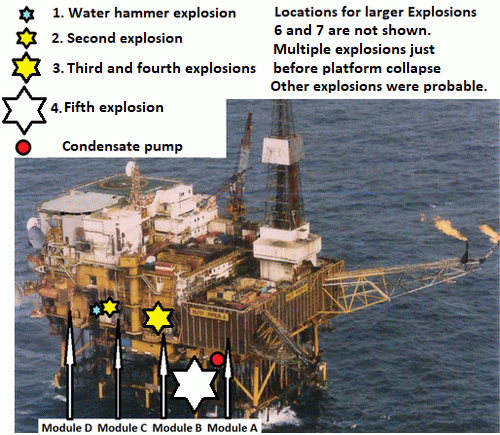
Figure 1: Piper Alpha oil platform. Approximate explosion locations. (Adapted from 'The public inquiry into the Piper Alpha disaster').
(Image by UK government) Details DMCA
Incorrect Piper Alpha Reports - An Errant Detonation Denial
The first explosion was ignored. Furthermore, Cullen incorrectly claimed that detonations did not occur during a second explosion on that platform, or offshore rig. Cullen's report stated that a 'detonation [was] highly unlikely, the gas cloud not being large enough'. Considering the water hammer explosion mechanism instead of a leaking flange, there was certainly sufficient fuel to detonate.
To background this article, short definitions for an explosion and a detonation are required. A bit of science is used here to describe detonations. Although more technical, an explosion is a sudden release of energy, and a detonation emits a shock wave, or blast of pressure, from an explosion. Outside of this discussion in this paper the term detonation is used interchangeably with the term detonation.
When you light a match, you do not hear or feel a shock wave. The same is true for some explosions.
Wavering flames emit sounds. For example, large gas pipeline fires have been reported to sound like jet aircraft engines. The loudness of the whooshing sound depends on how much fuel you throw on the fire.
That is, shock waves explode from detonations, and shock waves do not explode from fires or some types of explosions. For example, if you throw a gallon of gasoline on a fire an explosion occurs, but a detonation wave does not occur. The 'whoosh' of an explosion is heard, but the 'bang' or 'boom' of a detonation is not heard from the flames.
As a detonation example, when you light a firecracker, you hear a shock wave from the explosion. If your hand is close to the firecracker when it goes off, you feel that shock wave.
A shock wave's travel distance and force depend on the energy of the explosion and the type of fuel. Note that a detonation wave in methane travels near 1733 meters per second (3877 mph). A shock wave in air travels at 343 meters per second (767 mph).
An explosion can burn you. A detonation can break your bones. Both explosions and detonations can cause objects, or missiles, to shoot through the air.
Incorrect Piper Alpha Reports - Reported Detonations
The detonation to prove that a water hammer explosion ignited was dismissed from consideration by Cullen. Detonations were reportedly heard at 0 seconds (Explosion 2, 22:00), 2-3 seconds (Explosion 2), 10 seconds (Explosion 3), time not reported (Explosion 4), 20 seconds (Explosion 5), 24 minutes (Explosion 6), 30 minutes (Explosion 7), and 70.8 minutes (Platform collapse and multiple explosions, 23:20). Vibrations from Explosion 7 were felt a mile away.
A series of explosions ignited as the Piper Alpha began to fall into the sea. Between 23:30 and 00:45, the center of the platform collapsed. In less than an hour and a half, the Piper Alpha was gone. Detonations have now been associated with specific Piper Alpha explosion events. In fact, 8 explosions were reportedly heard, and all of those explosions are accounted for. Other explosions may have occurred as well. Cullen dismissed reported explosions that did not support his leaking flange explosion theory.
An open question concerns the validity of the audio feed in videos, which were compiled from still photos. The audio was likely added later, but detonations were heard by witnesses.
Incorrect Piper Alpha Reports - A Detonation Versus an ExplosionDifferent witnesses heard different explosions. People on the Piper Alpha were knocked out of their chairs by an detonation. Certainly, explosions detonated on the Piper Alpha rig since shock waves were physically and audibly experienced by personnel.
Also, a detonation wave shook a 2,645-gross-ton, 72-meter-long ship, which was located 25 meters from the oil rig. As evidence, the captain of the nearby Lowland Cavalier ship stated that 'I did not hear the explosion. I felt it and saw it.' The second Pipe Alpha explosion at 2-3 seconds was the explosion that a ship captain saw and felt. One person on this ship was blasted into a bulkhead.
A diver heard both the first and second explosions. Clearly a detonation occurred.
In other words, a detonation was reported by witnesses during the second Piper Alpha explosion, yet the official report from the United Kingdom government falsely claimed that detonations did not ignite at the time of the second explosion.
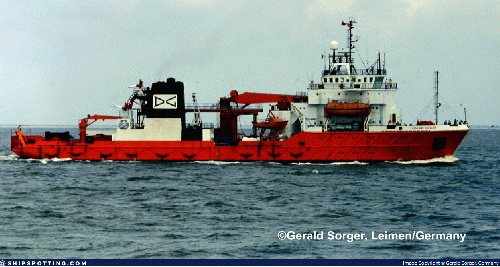
Figure 2: Lowland Cavalier - 5.2 million pounds - shook from shockwaves
(Image by Gerald Sorger) Details DMCA
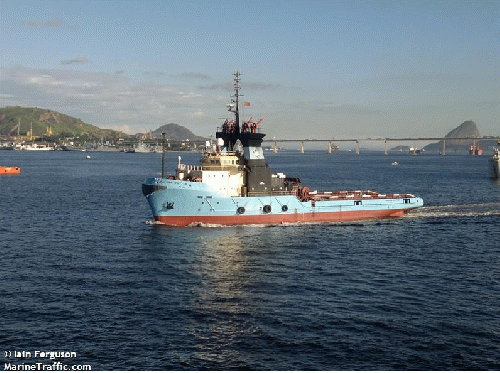
Figure 3: Maersk Cutter - 4.56 million pounds - Shook from shockwaves
(Image by Iain Ferguson) Details DMCA
The Piper Alpha Explosion Cover-up
This misstatement of fact with respect to this detonation both complicated and hindered all subsequent investigations. That is, facts were intermingled with fiction during different investigations.
No matter how I look at these facts, a lie was told in the official report. Such a lie constitutes a cover-up of serious explosion dangers to the oil and gas industries. The definition of a lie is to 'to present false information with the intention of deceiving'. This lie concealed water hammer explosion dangers for decades.
The Honorable Lord Cullen, Secretary of State for Energy by Command of Her Majesty, represented the United Kingdom. He lied, therefore the UK government lied. The Lowland Cavalier ship weighed 5.2 million pounds. Shock waves vibrate structures, pressure changes do not. The detonation wave also vibrated the 2070 ton Maersk Cutter (4.56 million pounds). Millions of pounds of steel would only shake when you 'bang' against the ship.
Cullen endorsed the false story that an overpressure shook the ship. Such a claim is like saying that the wind bangs on the door of your home, which defies facts. Detonation waves effectively hammer against an object.
Look at Figures 2 and 3. Do you believe that these ships can be shaken by just pushing on the ships? Or do you believe that something banged on the ships to make these ships vibrate? To claim that a shock wave did not strike this ship is 'to present false information with the intention of deceiving.'
Cullen's false claim that a detonation did not ignite supported his false conclusion that the Piper Alpha explosions were caused by a flange leak. Accordingly, calculations, tests, and results in his report were based on a lie. The facts were misrepresented. To risk lives, this lie smolders as an ongoing cover-up since 1988.
Explosions can be Detected, Recorded, and Prevented
Of parallel importance, explosions cannot be measured using standard instruments. The detonation pressure wave travels too fast to measure. Thermocouples and other temperature-measuring devices are incapable of measuring explosion temperatures. Standard pressure transducers are incapable of measuring explosion pressures.
However, high-frequency pressure transducers can be installed in piping systems to measure and record explosion-pressure measurements. These devices record significant amounts of data, and software can be adjusted to only store the data associated with the high pressures during detonations. By doing so, every explosion in the oil and gas industry can be recorded for forensic analysis for large explosions and fires.
Similarly, smaller explosions go unrecorded, and using these piezoelectric transducers will record all oil and gas explosions. A piezoelectric transducer acts like the push-button spark source for a gas grill. When compressed, an electric charge is emitted. For a pressure transducer, these electric charges are accurately measured when an explosion pressure strikes the transducer. The changes in electrical charge are recorded as changes in pressure.
By recording all explosions, large and small, future explosions can be controlled and prevented.
Incorrect Piper Alpha Reports - A Water Hammer Explosion versus a Flange Leak
Even more importantly, earlier reports and videos did not report the first Piper Alpha explosion - the water hammer explosion. I first published this water hammer theory for offshore platforms in 2013 ("Explosions: A fresh look at Chernobyl, Three Mile Island, the Gulf Oil Spill, and Fukushima Daiichi", 2013, Click Here; "Mensa Foundation honors Dr. Robert Leishear for creative intelligence", Click Here).
Prior to the research discussed here, this water hammer-detonation mechanism was not identified in research with respect to the Piper Alpha disaster. Technical calculations were wrong, and facts were improperly dismissed from consideration. As a direct result, previous studies incorrectly reported that a leaking flange started the entire Piper Alpha explosion process, as the cover-up continued. This leaking flange explosion theory persisted until now and may persist for a long time to come.
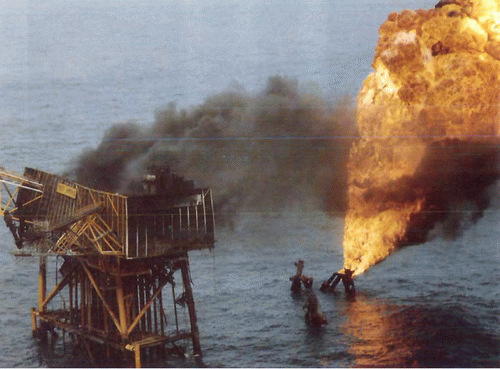
Figure 5: Piper Alpha oil rig fire damages after explosions - Most of the oil rig sunk into the North Sea.
(Image by UK government) Details DMCA
The Piper Alpha Explosion Cover-up Continued
Other previous reports and videos were fundamentally flawed since Cullen's flawed reports have never been publicly questioned. These mistakes have not been challenged until now.
The Smithsonian, National Geographic, and others applauded Cullen's work, and rightly so for the extensive research that was performed. However, incorrect findings were glossed over with respect to water hammer explosions, and these new findings can prevent loss of life. Major news sources were obviously unaware that they had been dragged into a cover-up of explosion causes in the oil and gas industry.
Accordingly, other incorrect findings by Cullen were accepted. Cullen's conclusions about a leaking flange were incorrectly accepted as fact. Once the water hammer-explosion mechanism was understood, many other discrepancies were noted in Cullen's report. These falsehoods discolored all subsequent investigations.
Specifically, the Smithsonian claimed that "The exhaustive inquiry into the Piper Alpha disaster had a tremendous impact on safety regulations.' Selectively choosing which facts to accept and which facts to discard clouds any investigation of facts.
Hidden Explosion Dangers
Once Cullen dismissed a water hammer explosion, there was little reason for engineers or scientists to further investigate this explosion cause for offshore platforms since 1988. This Piper Alpha error thwarted new research.
Hand in hand with recent investigations of similar nuclear power plant explosions, I am investigating oil and gas industry explosions as well. My investigation of the Piper Alpha explosions is the first detailed gas industry investigation during this one-man research project ("Preventable Disasters--The Fight for New Ideas, Never Give an Inch").
I have been writing about this cause of death for 9 years, while deaths continue in the oil and gas industries. This case study of the Piper Alpha explosions is the first experimental proof of oil and gas water hammer explosions.
A Government Cover-up Affects Many Explosions and Fires
Notably, oil rig explosions and fires have other causes. Some disasters are caused by ship collisions, and other disasters have been attributed to unknown causes. Some of these unknown causes - water hammer explosions - can be explained and prevented by the new science presented here.
The number of fires and explosions is substantial. Due to different causes, there were 1525 fires and 38 explosions between 2007 and 2020 in waters that are controlled by U.S. regulations (Table 1). Many explosions were probably caused by water hammers.
The number of oil and gas platform explosions and fires throughout the world are higher, of course. Water hammer explosions are certainly an explosion cause, and this explosion cause has not been investigated by regulators or industry officials. Effectively, such explosions have been covered up.
The United Kingdom, Piper Alpha investigation flaws have blockaded new ideas and research for decades. We do not know how many water hammer explosions in the oil and gas industry preceded the Piper Alpha water hammer explosion. We do not know how many water hammer explosions in the oil and gas industry followed the Piper Alpha water hammer explosion.
We do not know how many explosions have been caused by water hammers. We do not know how many fires have been caused by water hammers.
We do not know what really happened at many offshore disasters. We do not know how many people have died unnecessarily as a result. We now know that at least 167 people dies due to a water hammer explosion.
Many Explosions and Fires Can Be Prevented
Now that this primary oil and gas rig explosion cause has been identified, oil and gas rig explosions can be prevented. Air enters piping during maintenance and other operations. After such operations are performed, preventive actions are essential.
- Air needs to be vented from the piping.
- Oxygen concentrations in the accessed pipes need to be measured to ensure that explosions cannot occur. Nitrogen purges may not be effective to prevent explosions.
- Valve and pump operations should be controlled to prevent explosive pressure conditions.
- High-frequency pressure transducers should be installed in piping to measure all explosions, big and small, that ignite in oil and gas systems.
- Offshore operators need training to understand this relatively new explosion theory to protect their lives and prevent explosions and fires on the oil and gas rigs on which they work.
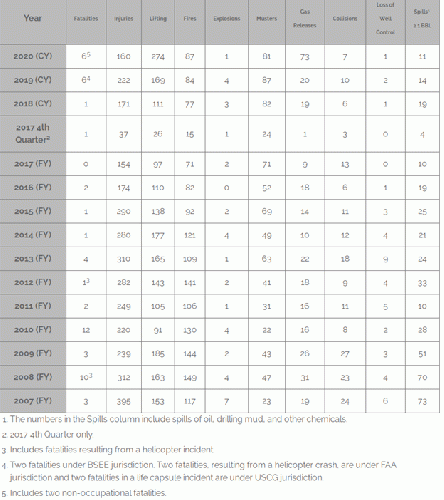
Table 1: Offshore Oil Rig Accidents ('Offshore Incident Statistics').
(Image by US government) Details DMCA
The U.S Government Risks the Lives of our Workers
Yes, such actions will be expensive. In my opinion, lives are worth spending money, but this opinion is not shared by everyone.
This research has been performed, and continues to be performed, on my own time and at my own expense, since U.S. regulators refused to finance this research (Bureau of Science and Environmental Engineering and the Department of Transportation). In fact, I sent 2014 emails to the BSEE, stating that
'I want to stop explosions, deaths and oil spills at offshore oil rigs.' 'Gas pockets in the piping are compressed to cause conditions for autoignition of flammable gasses.
'The common refrain of Swish, Run, Boom is explained by this theory. Swish when the gas expands in the piping as the oil and gasses rise in the piping from the sea floor. Run as the operators flee for their lives to escape the Boom of the explosion that they know will follow.
'If we understand the cause of offshore fires and explosions, we can stop them!"
That BSEE research proposal would have considered the Gulf Oil Spill to explain this offshore oil rig-explosion process. This Piper Alpha research accomplished the same goal to prove that water hammers explode and burn offshore platforms in preventable disasters.
In response to this proposal, the BSEE had "other, more relevant safety research". That is, the BSEE chose to accept deaths for offshore oil rig and gas rig workers, stating that the BSEE had higher priorities. In short, Cullen's report was based on technical errors, and BSEE inaction constituted a cover-up of oil rig-safety dangers. The BSEE callously endangers lives.
We do not know what really happened when the Gulf Oil Spill (Deepwater Horizon) ignited. Water hammers need to be investigated for this environmental disaster. The ongoing cover-up by BSEE affects the future safety of workers and the environment.
Never Give an Inch
I did what was needed on my own. I refused to stand by and accept the fact that federal regulators continue to unnecessarily risk lives. Their intentional neglect caused, and will continue to cause, preventable deaths unless actions are taken to reduce the number of offshore platform explosions.
The U.S. government refuses to act to save lives and refuses to act to prevent environmental disasters. Governments callously, unnecessarily, and irresponsibly scar our lands and waters and risk lives. This new research carves a path for others to follow to stop offshore oil and gas rig explosions and save lives.
Addendum
To alert affected organizations, the following email will be sent upon publication of this article.
To: The United Kingdom, Department of Energy, PHMSA, the U.S. Secretary of Energy, the U.S. Secretary of Transportation, the BSEE, the Smithsonian, and National Geographic
Incorrect Piper Alpha Investigation Report and Videos - Threats to Life and the EnvironmentTechnology has moved forward to explain Piper Alpha explosions and prevent needless deaths and oil spills, both on land and at sea. Specifically, misleading information in your reports and videos can kill oil rig workers. Recent publications prove that incorrect calculations were provided in Lord Cullen's 1990, United Kingdom, report on the Piper Alpha explosions and fatalities. Offshore oil rig explosions can be stopped. Another recent report proves that oil spills, like the Keystone oil spill in Kansas, can be stopped.
Many errors in Lord Cullen's Piper Alpha report carry over to corrupt subsequent videos and reports. The scope of this fundamental flaw is such that the lives of offshore oil and gas rig workers are jeopardized. Details and references are provided in "What Really Happened at the Piper Alpha Oil Rig Explosions - New Findings - Stop Killing Oil Rig Workers" (click here).
As part of an industry-wide cover-up, offshore oil spills and cross-country oil spills are better understood now than ever before. Yet, the U.S. government refuses to act to stop oil spills. "Offshore Oil Rig Explosions and Deaths Can Be Stopped - Piper Alpha Explosion Flawed Investigations - Stop Killing Oil Rig Workers" (click here), The Keystone Oil Spill in Kansas - The Mushroom Theory - Stop the Oil Spills, click here).
. Respectfully, comments and discussion are requested. Lives and the environment can be saved!
(Article changed on Dec 25, 2022 at 3:08 AM EST)





